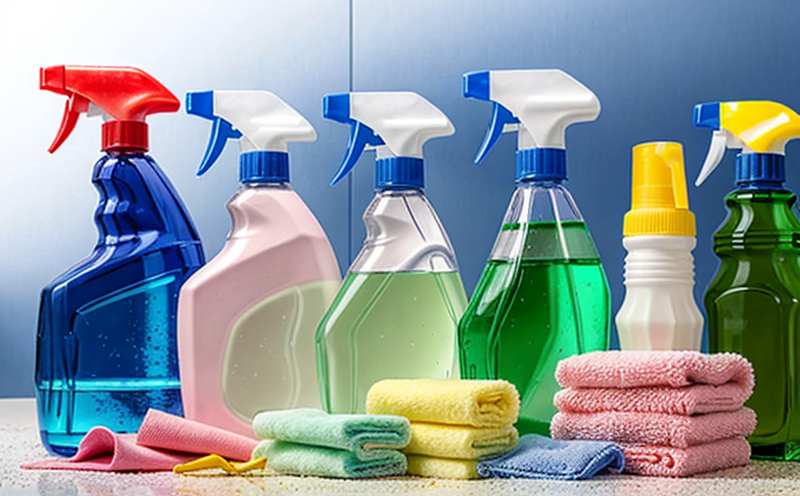pH Testing of Cleaning Products
Ensuring that cleaning products are safe and effective is paramount in consumer product development. The pH level of a cleaning product plays a critical role in determining its biodegradability, corrosiveness, and overall safety profile. In this section, we will explore the importance of pH testing for cleaning products, the standards that apply to it, its industry applications, real-world use cases, and frequently asked questions.
The pH value is a measure of how acidic or basic (alkaline) a solution is. For cleaning products, this metric can impact everything from the product's effectiveness in removing dirt and grime to its potential for skin irritation. Understanding and controlling the pH level ensures that the product performs as intended while remaining safe for users.
The testing process involves several steps: first, the specimen is prepared according to specific protocols tailored to the type of cleaning product being tested. Next, a pH meter or similar instrument measures the sample's pH value. This measurement must adhere to defined acceptance criteria, which vary by product and regulatory requirements.
Industry standards such as ISO 14025:2017, ASTM D6983-16, and EN 12867 provide guidelines for pH testing of cleaning products. Compliance with these standards is essential to ensure the accuracy and reliability of test results. These standards outline various methods for sample preparation, measurement techniques, and acceptable ranges.
One key challenge in pH testing lies in maintaining consistent results across different batches or samples. This can be particularly difficult when dealing with highly reactive materials such as acids or bases used in some cleaning formulations. Ensuring accurate measurements requires precise instrumentation and meticulous sample handling.
The importance of pH testing cannot be overstated, especially given the increasing demand for eco-friendly and biodegradable products. Many consumers prefer green products that are less harmful to the environment. By conducting thorough pH tests during development, manufacturers can ensure their products meet these expectations while also complying with regulatory requirements.
Applied Standards
The ISO 14025:2017, ASTM D6983-16, and EN 12867 are widely recognized standards for pH testing of cleaning products. These documents provide comprehensive guidance on the correct procedures, equipment needed, and acceptance criteria.
ISO 14025:2017 focuses on environmental labeling and declaration, which includes information about a product's environmental impacts throughout its life cycle. The standard emphasizes the importance of accurate pH testing to ensure that cleaning products do not contribute significantly to water pollution or other harmful effects.
ASTM D6983-16 deals specifically with the measurement of pH in aqueous solutions, including those found in various types of cleaning products. This standard provides detailed instructions on how to prepare samples and calibrate instruments for accurate readings.
The EN 12867 standard covers the biodegradability testing of surfactants used in detergents and other cleaning agents. While not directly related to pH, it complements other tests by ensuring that the active ingredients break down safely after use.
| Standard | Description |
|---|---|
| ISO 14025:2017 | Environmental labeling and declaration guidelines |
| ASTM D6983-16 | Aqueous solutions pH measurement procedures |
| EN 12867 | Biodegradability testing of surfactants in detergents |
The combination of these standards ensures that cleaning products undergo rigorous testing to meet both environmental and safety standards.
Industry Applications
- Precision agriculture for soil pH correction
- Pharmaceuticals: Ensuring the stability of drug formulations
- Biofuels production to optimize fermentation processes
- Water treatment plants for effluent monitoring and control
| Application | Description |
|---|---|
| Precision agriculture | Ensuring optimal soil conditions for crop growth. |
| Pharmaceuticals | Maintaining the stability of drug formulations to ensure efficacy and safety. |
| Biofuels production | Optimizing fermentation processes through precise pH control. |
| Water treatment plants | Monitoring effluent to meet environmental regulations. |
These applications highlight the versatility of pH testing across industries, emphasizing its role in ensuring quality and compliance. In consumer product testing specifically, accurate pH measurements are crucial for creating safe and effective cleaning products that meet regulatory requirements.
Use Cases and Application Examples
- Formulation Development: During the early stages of product development, pH testing helps determine the optimal balance between active ingredients and stabilizers. This ensures that the final product is effective yet safe for consumers.
- Quality Control: Regular pH checks during production ensure consistency across batches. Variations in this critical parameter can affect both performance and safety.
- Labeling Compliance: Proper labeling of cleaning products requires accurate pH information to inform users about proper handling and storage conditions.
- Testing household cleaners for safe use around children and pets
- Assessing industrial detergents used in manufacturing environments
- Evaluating commercial disinfectants for effective sanitization
In each case, precise pH testing ensures that cleaning products meet the highest quality standards and regulatory requirements.





